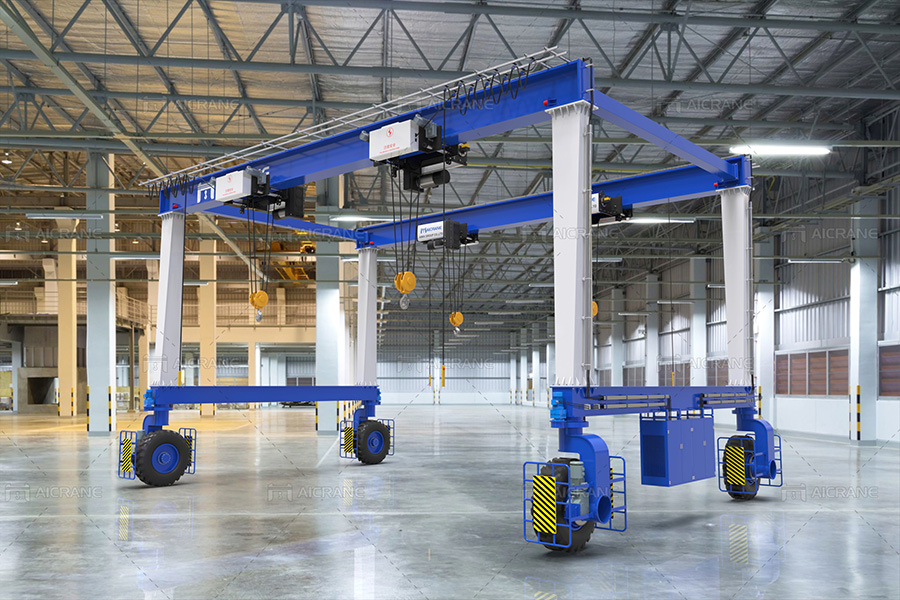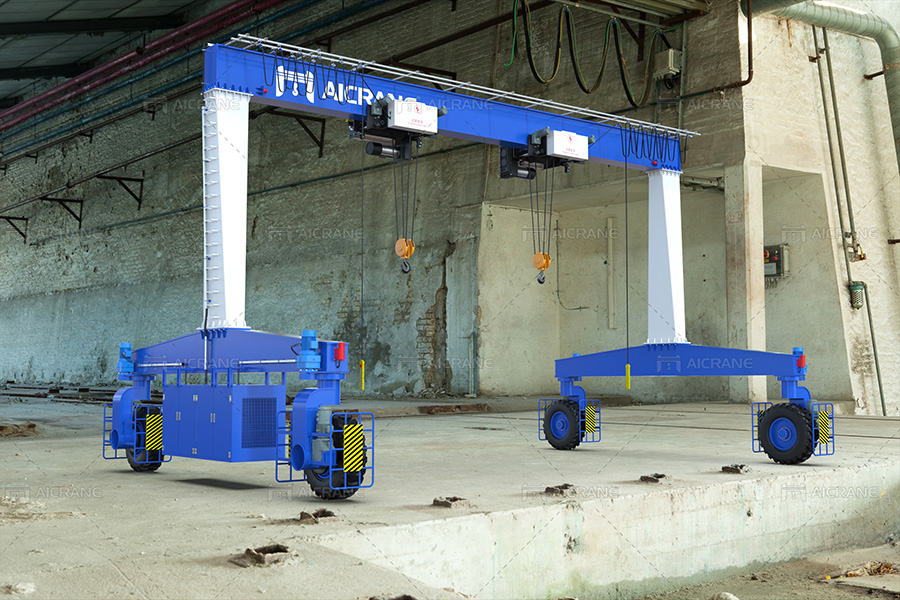In the evolving landscape of industrial machinery, the integration of smart technology into rubber tyred gantry cranes (RTGs) marks a significant leap forward. These cranes, pivotal in container handling and other heavy-duty lifting applications, are becoming more sophisticated with the advent of smart technology. This article explores how smart technology is transforming RTGs, enhancing efficiency, safety, and overall performance.

1. Understanding Rubber Tyred Gantry Cranes
Rubber tyred gantry cranes are versatile and mobile lifting solutions used in container terminals, warehouses, and construction sites. Unlike rail-mounted gantry cranes, rubber tyred gantry cranes for sale move on rubber tires, allowing them to traverse various surfaces and provide flexible operation. Their primary function is to stack and move containers or heavy loads, making them essential in logistics and heavy industries.
2. The Role of Smart Technology in RTGs
Smart technology encompasses a range of advanced tools and systems designed to enhance the functionality and performance of RTGs. This includes the integration of sensors, IoT (Internet of Things), telematics, and data analytics. Here’s how these technologies are revolutionizing RTG operations:
a. Real-time Monitoring and Diagnostics
One of the most significant benefits of smart technology is real-time monitoring. RTGs equipped with sensors and IoT devices can provide continuous data on various operational parameters, such as load weight, tire pressure, engine performance, and hydraulic system status. This data is transmitted to a central control system or cloud platform, allowing operators and maintenance teams to monitor the crane’s condition in real time.
Benefits:
- Early Detection of Issues: Real-time monitoring enables the early detection of potential issues, such as mechanical faults or performance degradation. This proactive approach helps in scheduling timely maintenance, reducing the risk of unexpected breakdowns.
- Enhanced Performance: By continuously tracking performance metrics, operators can optimize the mobile gantry crane usage and ensure it operates at peak efficiency.
b. Predictive Maintenance
Smart technology facilitates predictive maintenance by analyzing historical and real-time data to predict potential failures. Advanced algorithms process data collected from sensors to identify patterns and anomalies that might indicate upcoming issues.
Benefits:
- Reduced Downtime: Predictive maintenance allows for planned maintenance activities, minimizing unscheduled downtime and improving overall equipment availability.
- Cost Savings: By addressing maintenance needs before they escalate into major problems, companies can reduce repair costs and extend the lifespan of their RTGs.
c. Automated Controls and Optimization
Automation is another key aspect of smart technology integration. RTGs equipped with automated controls can perform tasks with greater precision and efficiency. For instance, automated stacking systems use sensors and software to determine the optimal stacking pattern for containers, improving space utilization and reducing handling time.
Benefits:
- Increased Efficiency: Automated systems streamline operations, leading to faster and more accurate handling of loads. This efficiency is crucial in high-demand environments like container ports.
- Consistency and Accuracy: Automation reduces human error, ensuring consistent performance and accuracy in load handling.
d. Enhanced Safety Features
Safety is paramount in the operation of RTGs, given the heavy loads they handle. Smart technology enhances safety through various features:
- Collision Avoidance Systems: Sensors and cameras integrated into RTGs can detect obstacles and prevent collisions. These systems alert operators to potential hazards, reducing the risk of accidents.
- Load Monitoring: Smart load monitoring systems ensure that the crane operates within its specified load limits, preventing overloading and potential structural damage.
Benefits:
- Improved Operator Safety: Enhanced safety features protect operators and other personnel working in the vicinity of the RTG.
- Reduced Accident Rates: Collision avoidance and load monitoring systems contribute to a safer working environment and reduce the likelihood of accidents.

e. Data Analytics and Reporting
The data collected from smart technology can be analyzed to gain insights into overhead gantry crane performance and operational trends. Advanced analytics tools process this data to generate reports and visualizations, helping managers make informed decisions.
Benefits:
- Operational Insights: Data analytics provide valuable insights into operational efficiency, allowing managers to identify areas for improvement and implement corrective measures.
- Performance Benchmarking: Analytics enable benchmarking against industry standards and performance metrics, facilitating continuous improvement.
3. Case Studies: Real-World Applications
Several companies have successfully integrated smart technology into their RTGs, demonstrating the benefits and potential of these advancements.
Case Study 1: Port of Rotterdam
The Port of Rotterdam, one of the largest and busiest ports in Europe, has implemented smart technology in its RTG operations. By equipping RTGs with IoT sensors and real-time monitoring systems, the port has achieved significant improvements in operational efficiency and safety.
Results:
- Enhanced Efficiency: Real-time data allows for optimized scheduling and reduced waiting times.
- Improved Safety: Collision avoidance systems and load monitoring contribute to a safer working environment.
Case Study 2: Shanghai International Port Group
Shanghai International Port Group (SIPG) has integrated advanced automation and data analytics into its RTG operations. Automated stacking systems and predictive maintenance have transformed their container handling processes.
Results:
- Increased Throughput: Automation has led to faster container handling and increased throughput.
- Cost Savings: Predictive maintenance has reduced maintenance costs and extended crane lifespans.
4. Future Trends and Developments
As technology continues to evolve, the future of smart RTGs looks promising. Emerging trends include:
- Artificial Intelligence (AI): AI-driven systems will further enhance automation, predictive maintenance, and data analytics capabilities.
- Integration with Smart Ports: RTGs will increasingly integrate with smart port systems, enabling seamless communication and coordination with other equipment and operations.
- Sustainability: Smart technology will play a role in making RTGs more energy-efficient and environmentally friendly.
5. Conclusion
The integration of smart technology into rubber tyred gantry cranes represents a transformative development in the industrial sector. By leveraging real-time monitoring, predictive maintenance, automation, and advanced safety features, RTGs are becoming more efficient, reliable, and safe. As technology continues to advance, the potential for further enhancements in RTG performance and capabilities is immense, paving the way for a more efficient and sustainable future in heavy lifting solutions.